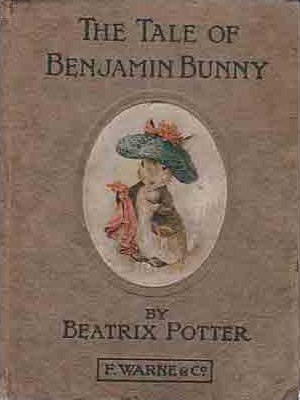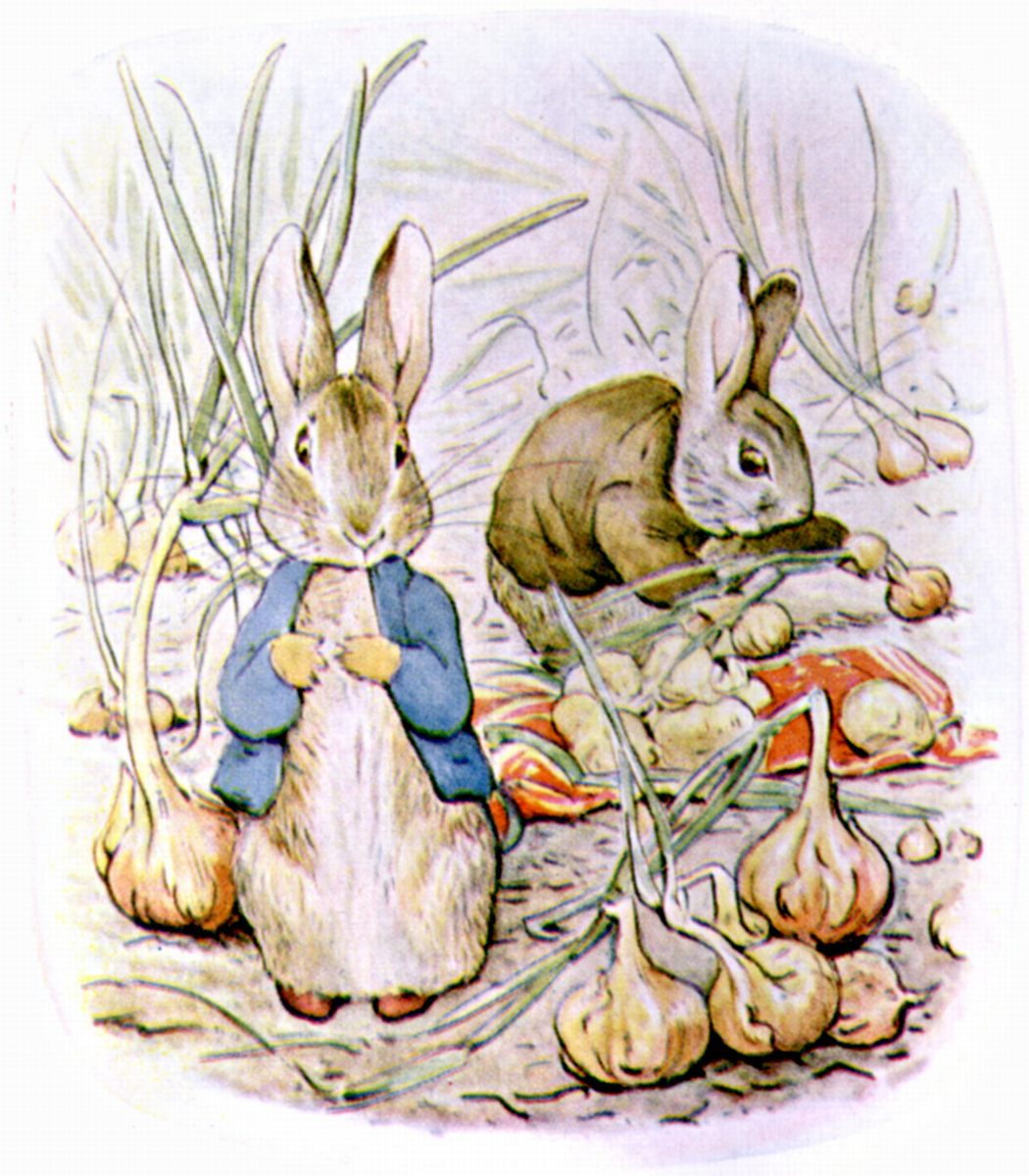The Tale of Benjamin Bunny is a children’s book written and illustrated by Beatrix Potter, first published by Frederick Warne & Co. in September 1904. A sequel to The Tale of Peter Rabbit (1902), it tells of Peter’s return to Mr. McGregor’s garden with his cousin Benjamin to retrieve the clothes he lost there during his earlier adventure. In Benjamin Bunny, Beatrix developed the rabbit universe she created in Peter Rabbit, and in doing so suggested that the rabbit world was parallel to the human world, but complete and sufficient unto itself.
Benjamin Bunny was an instant commercial and popular success, and thousands of copies were in print by the end of 1904. The Times Literary Supplement thought Beatrix’s illustrations “pencil perfect”,[1] but suggested that she engage a literary assistant for future productions. Beatrix created a nursery wallpaper tapping Benjamin’s image,[2] and he returned as an adult rabbit in the Flopsy Bunnies and Mr. Tod. Benjamin Bunny was adapted in 1992 as an episode of the BBC animated television series The World of Peter Rabbit and Friends.
Plot
When Mr. McGregor and his wife leave home in their gig, a light, sprung cart pulled by a single horse. Benjamin Bunny and his cousin Peter Rabbit venture into Mr. McGregor’s garden to retrieve the clothes Peter lost there in The Tale of Peter Rabbit. They find the blue jacket and brown shoes on a scarecrow, but Peter is apprehensive about lingering in the garden because of his previous experience. Benjamin delays their departure by gathering onions, which he wraps in Peter’s handkerchief, hoping to give them to his aunt, Peter’s mother. He then takes a casual stroll around the garden, followed by an increasingly nervous Peter.
Rounding a corner, they see a cat and hide under a basket, but the cat then sits on top of the basket for five hours, trapping the pair. Benjamin’s father enters the garden looking for his son. He knocks the cat away from the basket and locks her in the greenhouse, then rescues Benjamin and Peter. But he also punishes them for going to Mr. McGregor’s garden by whipping them with a switch he had brought. Once home, Peter gives the onions to his mother, who forgives his adventure because he has recovered his jacket and shoes. Following his return, Mr. McGregor is puzzled by the ridiculously small footprints, the scarecrow’s missing clothes and the cat locked in the greenhouse.
Background
In 1901 Beatrix privately published The Tale of Peter Rabbit, and in 1902, Frederick Warne & Co. published a trade edition of the book, which was hugely successful. In 1904, she followed Peter Rabbit with its sequel, The Tale of Benjamin Bunny, and continued the rabbit saga in 1909 with The Tale of the Flopsy Bunnies and in 1912 with The Tale of Mr. Tod. All the tales were in part inspired by Joel Chandler Harris’s Uncle Remus stories, which Beatrix illustrated as early as 1893 in an attempt to find a career direction. She was unable to successfully translate Harris’s characters to the English country garden, but she transformed the American author’s “lippity-clippity, clippity-lippity” to “lippity-lippity” in Peter Rabbit, and used his “rabbit tobacco” (lavender) in Benjamin Bunny and Mr. Tod. None of her rabbit characters were based on Br’er Rabbit; Harris’s rabbit wins by cunning, but Beatrix’s Benjamin and Peter win by pure luck. The Beatrix Potter scholar Ruth K. MacDonald has assessed Beatrix’s rabbit universe as a more pleasant place than that found in Harris’s stories.[3]
Composition and publication

Wikimedia Commons
In July 1903, Beatrix suggested to her publisher Frederick Warne & Co. that the book to follow The Tale of Squirrel Nutkin and The Tailor of Gloucester ought to be something less complex than the two previous productions. She had several possible stories in mind and outlined them for the firm, but was anxious to settle on a choice as quickly as possible to guide her sketching while on holiday. It was decided between Beatrix and her publisher that one of the two books for 1904 would be Benjamin Bunny.[5][6] Benjamin Bunny had been mentioned in the manuscript of the privately printed edition of Peter Rabbit but had been dropped as irrelevant to the tale. A picture of his father was included in the private edition although he has no part in the story.[4]
Beatrix was sensitive to the beginnings and endings of her books and usually avoided the conventional at those key places. The publisher did not like the Benjamin Bunny ending, but Beatrix refused to alter it to their suggested “happily ever after” because such an ending in her estimation was “rather trite” and “inexact”. She suggested the last paragraph as it now appears in the book with the comment, “I would like the book to end with the word ‘rabbit-tobacco’, it is a rather fine word.”[7] She rewrote several other passages including twice rewriting the passage depicting Mr. McGregor’s discovery of the cat locked in the greenhouse.[8]
Summering at Fawe Park in Keswick, Cumbria with her parents, Beatrix filled her sketchbook with pictures of the estate’s several gardens including the kitchen garden and its greenhouses, cold frames, potting shed, and espaliered fruit trees. Her father photographed Fawe Park and Beatrix probably used his photographs (or her own) as an aid in her work.[9] The picture of Old Mr. Bunny attacking the cat did not satisfy her publisher, and she redrew it as she did the picture of Benjamin and Peter standing on the garden wall.[10] In Peter Rabbit, Mr. McGregor’s garden was in Perthshire, but in Benjamin Bunny the rabbit clan and the garden setting were moved to the Lake District, where they remained for The Tale of Mr. Tod, the final book of the Peter Rabbit saga.[11]
During her London winter,[12] Beatrix developed her work, and, by the middle of June 1904, Benjamin Bunny was almost finished.[13] Many of the sketches from her Fawe Park holiday were little altered in their migration to the book,[14] and, upon completion of the work, Beatrix declared she was relieved to be finished with the rabbits.[15]
The book was dedicated to “the children of Sawrey from old Mr. Bunny”.[13][16] Beginnings and endings of tales were important to Beatrix, and she that specified Benjamin Bunny was to end with the words, “rabbit tobacco” – a term from Uncle Remus she had made her own.[13]
Twenty thousand copies were published and released in September 1904. Within a month, reprints were ordered, and another ten thousand copies were printed at year’s end. Much to her embarrassment, Beatrix realized “muffettees” (a muff worn at the wrist) was misspelled, but the error was not corrected until the third printing.[17]
Illustrations
Beatrix borrowed a cat,[18] and took a pet rabbit to Fawe Park as models. Her meticulous preparation before finalizing an illustration was noted in a letter to Warne: “I think I have done every imaginable rabbit background and miscellaneous sketches as well – about seventy! I hope you will like them, though rather scribbled.” Scribbled or not, the work is of the highest quality with the sketches of onions and red carnations (which were dropped as the frontispiece) being chief examples. The illustrations communicate her obvious appreciation and love for the humble pots, onions, and flowers of the garden. Many of the objects in the illustrations – the gate, the potting shed, the wall – have changed little over the years and are recognizable today from her illustrations.[19] Aware the type of story she was writing was set primarily in colours of fawn, brown, and soft green, Beatrix wrote that, “the (red) handkerchief will make a good bit of colour all through the book.”[20]
Critical reception
The tale was well received by the Scotsman,[17] but The Times Literary Supplement was not entirely enthusiastic:
The Beatrix Potter biographer Linda Lear notes that none of the rabbit books subsequent to Peter Rabbit appealed to Beatrix with the passion she experienced for the original, but in Benjamin Bunny she successfully wrote a simple, didactic tale for very young children that was less complicated than The Tale of Squirrel Nutkin and The Tailor of Gloucester. But Benjamin Bunny lacked the vitality of her previous efforts, because it was made to order rather than allowed to flower from a picture letter to real children in the manner of Peter Rabbit and Squirrel Nutkin. The weak story line of Benjamin Bunny is evidence of her dwindling interest in continuing the Peter Rabbit saga, but the book displays a delight in place, a deep understanding of rabbit anatomy and behaviour, and beautifully miniaturized illustrations of vegetable gardens. Benjamin Bunny presented demands upon Beatrix she had not encountered in her previous three tales. She had depleted all her sketchbook backgrounds in the production of the other tales and was forced to create new ones, but the greatest challenge to Beatrix’s artistry was consciously working to satisfy her publisher’s demand for another commercial success and her public’s expectation of a tale as delightful as her others, while labouring under the pressure to produce a sequel to a work of genius.[21]


